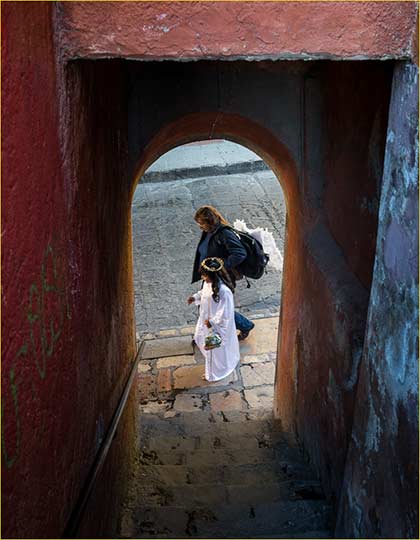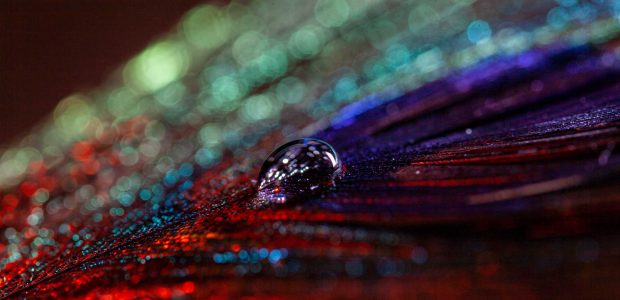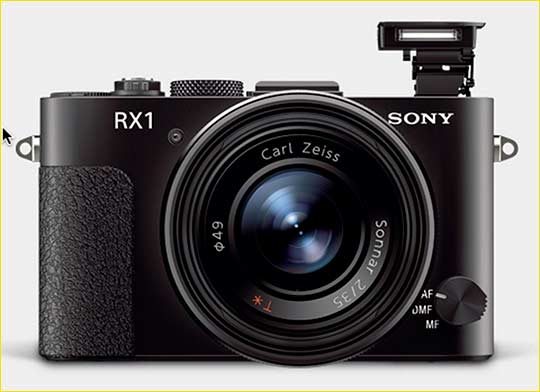
Introduction
TheSony Cybershot RX1 meets the definition of the wordunique. It is a 24 Megapixel full-frame camera that comfortably fits in a coat pocket and which features an integrated 35mm f/2 silent leaf shutter Carl Zeiss lens. It shoots video at 1080P/24 and 60P full HD, has a built in flash, a standard flash accessory shoe, and a manual aperture ring on the lens.
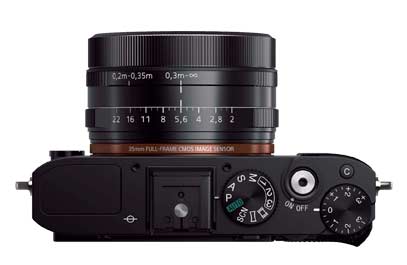
The top panel has the usual mode dial and also an exposure compensation dial. On the front panel is an autofocus mode selection dial and the rear sports an excellent 3″ 1.2M dot LCD. There is also an available high resolution electronic viewfinder that connect via the standard accessory shoe using a proprietary new connector under its front lip.
I won’t list all the other features expect below when they are specifically discussed as part of my review.Sony’s web sitedoes a good job of listing all the bells and whistles.

What I will mention here is that the feel of the controls is among the finest that I have ever encountered on any camera. Only an M Leica is comparable. Every knob, switch and dial on the RX1 is solid, has firm detents, and overall the whole camera feels like it would survive reentry from orbit, or at least six months in a pannier on a round-the-world bicycle trip.
I am particularly enamoured of the lens aperture ring. I usually shoot in Aperture Priority or Manual mode, and having a traditional lens aperture ring is a real bonus for me. This is where the damn things are supposed to be! Each third stop position is firmly detented, and the f/ numbers and in-between tick marks are engraved in the metal, not just painted on. Absolutely top quality, and supportive of the premium price that the camera demands.
From a functional point of view I only wish that the rear LCD was articulated. I know that Sony’s engineers struggled mightily to put a full frame sensor into a camera this small, but I believe that a simple tilt hinge wouldn’t have added that much. What I do agree with is not having a built-in EVF. Not that I wouldn’t want one. But, when you hold the camera and look at the rear LCD almost completely filling the rear panel, you realize that the only way one could be built in would be to make the camera bigger, which Sony clearly didn’t want to do.
Biking Through. San Miguel de Allende, Mexico. December, 2012
Sony RX1 @ ISO 125
The Lens
The built-in Carl Zeiss 35mm f/2 Sonnar is a spectacular lens. Building a lens of this focal length and wide aperture, that has as short a register distance as this one does, and to cover a full-frame sensor at such a narrow distance is a true optical engineering feat.
Lens charts tell part of the story, but during a couple of weeks of field shooting prior to publishing this review I found little to quibble about and much to like. There is some longitudinal chromatic aberration wide open, but it essentially disappears by f/4. Otherwise the Sonnar performs much the way you’d expect a top-quality Zeiss wide angle lens to. Quite excellent.
Below is the MTF chart for this lens. If this was a 90mm f/2 I’d be impressed, but for a wide-angle full-frame coverage lens this purported level of performance is astonishing.
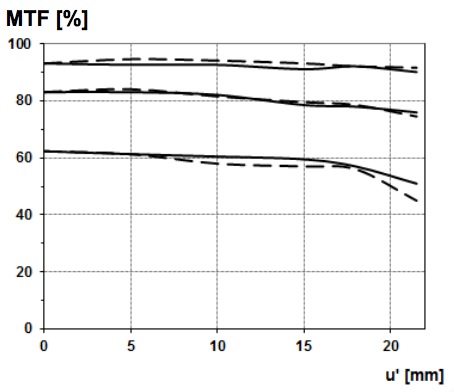
Sony Zeiss 35mm f/2 Sonnar
Link to Zeiss White Paper PDF on How to Read an MTF Chart
Keep a few things in mind as you look at this chart. Firstly, this is theoretical performance, not the measurement of an actual lens. Many lens makers do this because it creates a level playing field. Series variability does exists in manufacturing, and so a hand-picked lens chosen for testing might perform differently from the run-of-the-mill. By using theoretical performance it is possible to compare different lenses over time with a consistent reference base.
Secondly, manufacturers are known to measure MTF differently than each other. This makes comparing MTF charts between brands difficult if not impossible. For this reason I simply look at the overall impression that the MTF chart gives. How high and how straight are the lines, and how does wide-open compare to stopped-down? Based on this chart, coupled with my field experience and prints, – wow!
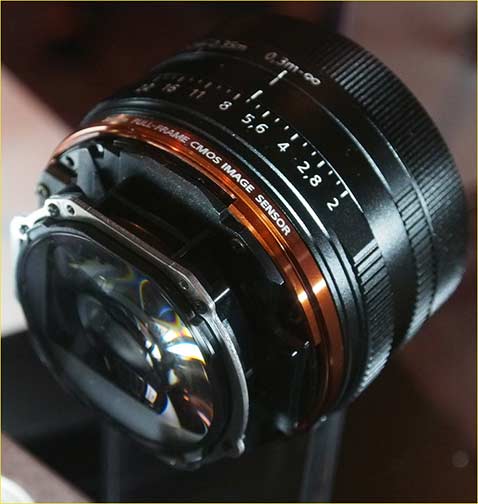
I’m not an optical engineer, but I found the above shot of the camera’s lens assembly separate from the body to be fascinating. The size of the rear element is huge compared to any comparable lens that I’ve ever seen. Given how close it sits to the sensor this was obviously a design necessity, along probably with a unique microlens layout on the sensor itself.
Zeiss’Sonnarlens design dates from the 1930s. It is optimized for fast apertures (f/2 or wider) and typically has high contrast and low flare. Sonnar designs are preferable on short register distance cameras (unlike DSLRs) and thus seems to be an ideal choice for the RX1.
I’d like to add a word about the issue of Sony and its use of Zeiss-designed lenses. Zeiss lens designs are used by Sony on a number of their cameras and stand-alone lenses. The way this works is that Sony gives Zeiss the design specifications and Zeiss does the optical design. Then the lens is built at a Sony facility, including manufacture of the glass itself, which may indeed come from a third party optical element fabricator. In any event, the design is by Zeiss and the final quality control is by Zeiss staff quality control engineers located at the Sony facility.
The question then is always asked is – is a Zeiss lens built by Sony in Japan as good as as Zeiss lens built by Zeiss in Germany? The answer is an unknown, and not one which really concerns me. I regard Zeiss and Leica as among the world’s best lens designers and builders, and whether this process takes place by technicians and engineers who eat either sushi or bratwurst for lunch is pretty much irrelevant. The proof is in the images, and the rest is web-wanker fodder, not much more.
Oh yes, those fantastic Zeiss CE and CF lenses that you might have on your Canon or Nikon camera. They are actually built for Zeiss by Cosina in Japan, not by Zeiss themselves in Germany. Same story. Japanese glass, mechanical design, and assembly. And, these are Zeiss branded and marketed lenses, not via a third party like Sony.
Want a Zeiss lens built totally by Zeiss in Germany? Look at the prices of some of their top Cine lenses.Gulp. Same thing with Leica lenses that are actually made in Germany. An M series 35mm f/2 Summicron costs more than the entire Sony RX1; camera, sensor and Zeiss lens combined.
Of course we should recognise that Panasonic does the same thing with Leica lenses. These lenses are designed by Leica, and then built by Panasonic under supervision by Leica staff quality control experts.
Angel Games. San Miguel de Allende, Mexico. December, 2012
Sony RX1 @ ISO 320
Autofocus and Manual Focus
Since the RX1 first was released there has been a lot of chatter about the speed and effectiveness of the camera’s autofocus. We need to keep in mind that the RX1 uses contrast detection AF, and thus is simply not going to be as fast in autofocusing as a DSLR with phase detection. Having said that, I have no real issue with the camera’s AF. I always use it with the focus assist light turned off , even in low light, (why advertise that you’re shooting?) Some people may niggle, but I just don’t find it much dissimilar to any other contrast detection AF system from Sony or other brands. Just not an issue for me, though there may be some who want to find it of concern.
Certainly if you’re a sports or wildlife photographer this isn’t the camera for you, though you knew that already, right? (Your first clue is the focal length). If you regularly shoot active rug-rats then maybe another camera may suit you better. Caveat emptor.
Speaking ofbeware– beware of the close focus ring on the lens. It is all to easy to accidentally turn it to the close focus position and then wonder why the camera isn’t focusing properly. This is, to my mind, one of the camera’s glaring design faults. An infrequently used control should not be so front-and-center, and then have the ability to be accidentally activated, and unable to be locked out.
Manual Focus – Peaking and Magnification
There is a front dial on the camera that allows for full auto-focus, full manual focus, or DMF with assisted manual focus. Autofocus has multi-point, user set point, or center point. Manual focus is fly-by-wire, but nevertheless has a smooth feel to it, and I have no complaints. You can have the image magnified to assist when manual focusing, and there is feature adjustable focus peaking. These two are married. In other words, you only get focus peaking along with magnified view. Some people complain about this, but not me. That’s when I want it and it generally all works really well.
Bear in mind that if you’re going to use manual focus you will get greater focusing accuracy by opening the aperture to the maximum, focusing, then closing it to shooting aperture before taking the shot. This is the way we’ve done it with all sorts of non-automated TTL focusing cameras for years. Just set your expectations to meet reality. This camera is what it is, and because of its specialized nature the sophisticated user will make allowances for the way it operates.
Blessed Silence & Stealth
I can’t stress this enough. The RX1 is almost totally silent in operation because of its leaf shutter. If you turn off the electronic focus confirmation sound all you hear is a soft “snick” when the shutter is released. Someone standing a few feet away, even in a totally silent room, won’t be able to hear it, and in any normal environment the camera is effectively totally silent. Of course there are many small cameras with leaf shutters that are also silent, but full-frame, 24 MP? No, nothing else past or present.
For real stealth you need to do a few more things. One is to turn off the focus assist light. I find that it hardly helps at all in any event, and simply draws unwanted attention to you and the camera. If you’re using either the optical viewfinder or the EVF, you can also turn off the rear LCD, and so in a dark environment there is nothing to give away the camera’s presence. Put a little black electrical tape over the white lettering on the front of the camera and you have about as discreet a street shooting and night shooting camera as one could wish.
Angel and Mother. San Miguel de Allende, Mexico. December, 2012
Sony RX1 @ ISO 500
The Price Question – Let’s Get it Out of the Way
The RX1 retails for about USD $2,800 at the time of its release in December, 2012. The only other current model 24 Megapixel full-frame cameras at the moment are the Sony A99 also priced at $2,800, the Canon 5D MKIII at $3,500, and the Nikon D600 at $2,000 (what a bargain!). The “end of life” Canon 5D MKII is about $1,800.
But, each of these is for a body only. You do want a quality lens to match the sensor’s resolving capability, don’t you? The RX1 comes with a superb 35mm f/2 Zeiss Sonnar lens. There is no exact equivalent interchangeable Zeiss lens, but the Zeiss Distagon 35mm f/2 in Canon or Nikon mount costs about $1,100. (The Sonnar design does not lend itself to DSLR configurations).
So what we see is that the RX1 at $2,800 is substantially less than any other full-frame camera. A Canon 5D MKIII with a Zeiss 35mm f/2 lens will cost $4,600, while a Nikon D600 with that same lens would be $3,100. The Sony A99 won’t take a Zeiss ZE or ZF mount lens, but even with an modestly priced 35mm lens will still be hundreds more than the RX1. And, of course, if you want to really talk expensive there’s the 18MP Leica M9 with 35mm f/2 Summicron, which will set you back just shy of $10,000.
“Ah ha”, you say. “But those cameras take interchangeable lenses, while the RX1 has a fixed lens“. My response to that is – “Of course it does“. But then the RX1 will fit in a coat pocket, which none of the others remotely will, and it also has a totally silent shutter, which for anyone doing candid street shooting, documentary work, or photojournalism is a huge plus, if not a must.
In other words, the RX1 is at the moment unique; the only compact-sized full-frame 35mm camera with a super-high-quality lens. My goodness – at $2,800 it’s almost a bargain. (Just kidding).
Of course we need to look at the competition, though these will have to be cameras with smaller and lower resolution APS-C sized sensors. The Fuji X100 has a 12MP sensor and costs $1,200, the Leica X2 has a 16 MP sensor with 24mm f/2.8 lens and costs $2,000. There is also the Sigma DP2 Merrill at $1,000, and I’ll have more to say about that further in this review.
Given this perspective I don’t find the RX1 to be at all over-priced. Some people see a $2,800 coat pocket sized camera and freak out. I see an amazing photojournalist’s tool with incredible image quality, and have no issue with where Sony has set the price – assuming, of course, that one can afford it.
Do keep in mind as well that the fit and finish of the RX1 are a noticeable step above those of most compact or fixed lens camera. I won’t say that it is Leica M quality, but it isn’t that far behind. Like a high quality watch, you look at it, hold it, and understand that the build and material quality is there, and that these things doesn’t come cheaply.
I’ll finish off this section by continuing the watch analogy. Some people are happy with a $35 Swatch or Timex. Looks fine, keeps good time. What more can one want? Then there are those that prefer and are able to own a $3,500 Breitling or Rolex. Time keeping accuracy isn’t the issue. It simply comes down to wanting, as well as being able to afford something because of its real or perceived excellence. Such is life in the “first world“.
Accessory Pricing

I will be less kind to Sony than I was above when it comes to accessory pricing. $180 for a lens hood? Gracious! One can buy a generic 49mm metal lens hood for $10. But, I will say that the Sony hood attaches to a special inner bayonet so that it doesn’t need to be mounted or unmounted when filters are changed. But $180 still seems more than a bit over the top.
The thumb grip is a freek’n $250. Now, it is a very special thumb grip. It mounts via the accessory shoe and has a hidden latch lever that prevents it from accidentally falling out. It is spring tensioned so that it can easily be folded backwards, which it needs to do since it covers the Playback button when in use. It really makes shooting comfortable, and it is a great piece of machined metal and engineering. But, there are whole cameras that cost less than this $250 thumb grip. Oh yes, and if you’re thinking of purchasing the EVF as well as the thumb grip, you may not want to bother, because with the grip attached you won’t be able to mount the EVF. It covers the EVF’s special connector. Only one of these can be used at a time. Pitty. Oh yes, similarly with an external flash. The hot shoe is taken by the grip, and while the grip itself offers a standard shoe mount on top, replacing the one it takes up, it’s a cold shoe and so no “hot” accessories can be used.
Match Technical’sThumbs Upfor a variety of cameras costs around $125, half the price of Sony’s device. Humm. Maybe with its folding and locking feature the RX1 thumb grip isn’t that outrageous after all.
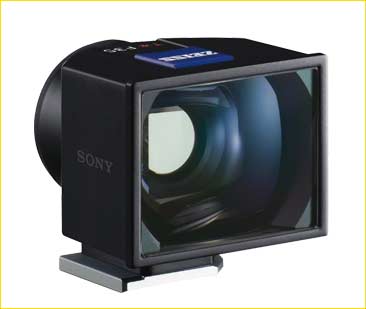
The EVF and the Optical Viewfinder, at $450 and $650 respectively are part of the same luxury accessory pricing approach. I must say that the EVF isn’t that much more than the one for the NEX cameras, and given that it uniquely fits the RX-1 at this time, doesn’t seem that overpriced. The Optical Viewfinder at $650 is though, even though its probably got great glass and has a Zeiss logo on it. A Voigtlander 35mm optical VF is around $210.
Electronic Viewfinder – EV1MK
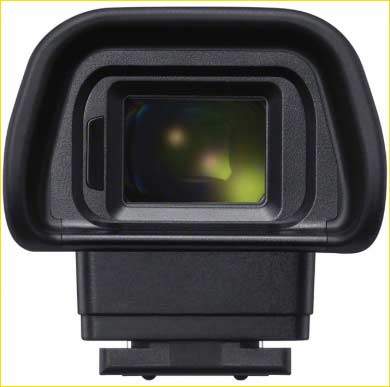
Sony’s EVFs, whether built into NEX or Alpha cameras or available as accessories, are among the best on the market. Though the accessory EV1MK is “supposed” to be the same as the one in the recent A99 and NEX-6 cameras, I don’t think so. I didn’t care for the one in theA99 when I reviewed it, though the NEX-6’s EVF seems fine to me. But the new EV1MK looks to be a next-generation device and a step beyond anything yet from Sony, or anyone else for that matter.
Regardless of the specs, which make it appear to be the same as other current Sony EVFs, visually comparing the EV1MK side-by-side with the one in the NEX-6 I can confirm that it seems to have a brighter, higher contrast and more lag-less image. Hell, I may even get used to EVFs and maybe get to like them if this is where the future is taking us.
The Battery / Charger Issue
I’m going to discuss the issue of the battery and charger in this section because it primarily pertains to pricing in this market segment. The RX1 comes with a USB cable and charger. The battery must be charged in the camera, via a USB cable attached to a computer or the provided wall-pack charger.
Not providing a stand-alone battery charger in a product in this price range is unconscionable. No photographer that I know who buys a camera of this type or price will tolerate having to leave the camera plugged in somewhere so that the battery can be charged. Just nuts.
Sony’s X series battery charger costs $50 at retail. This likely means that the manufacturing cost is sub $10. It really should be included with a pro-grade $2,800 camera. Yes, there are third party after-market batteries and chargers that are available and cost much less than Sony’s. But it’s the principal of the thing. Premium products shouldn’t nickel-and-dime their purchasers.
As for battery life, depending on ambient temperature, the amount of chimping and video usage, about 75 to 150 frames seems to be my real-world norm. This is pretty low, and a consequence of the battery being fairly small. Do yourself a favour – buy a couple of spares along with an external wall-pack charger. Complain like I do, if you must, but just do it.
The Packaging Issue
Which brings us to the final pricing related issue. The packaging of the RX1 is ordinary. Nothing particularly wrong with it, just your basic cardboard box. A thin paper manual, no software CD and no proper charger. It’s funny, because the camera’s provided lens cap is a heavy metal thing of beauty, so Sony isn’t cheaping-out. It’s just that I believe that they don’t see the overall high-end product picture. People paying big bucks for premium products want to have a pleasant out-of-box experience. Even though the box itself will likely go into the basement or garage until some years from now when it’s time to sell, trade-in, or be thrown away, attractive quality packaging is still important. I’ve seen $100 kitchen knives with more up-market packaging than the RX1.
Sony needs to realize that if they want to start playing in the high-end of the pricing pool, they need to treat their customers accordingly. Leave theGenuine Imitation Carpathian Burled Elmwooden grips andReticulated Ostrich Testicle Leatherbody coverings to Hasseblad and its re-branded NEX-based faux-luxuryLunarcameras. But don’t short-charge the savvy buyer with small economies that irritate, when the buying and unwrapping experience should be one of gratification.
Historical Predecessors
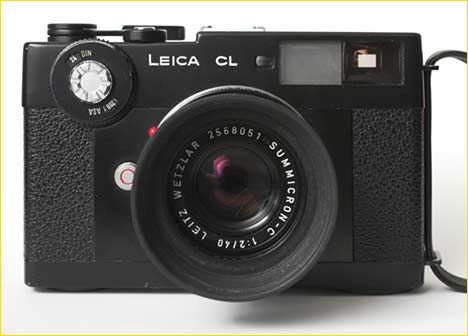
The moment I opened the box and held the RX1 in my hands I was immediately flashed back to the 1970s and the Leica CL. These cameras differ is so many ways that it’s not even worth beginning a comparison. But, they do share a similarity of size, heft and purpose. Even the Leitz Summicron-C 40mm f/2 lens has its similarities to the Zeiss 35mm f/2 on the RX1. Oh yes, and the CL was built for Leica by Minolta in Japan. I would like to think that with Sony the current owners of the Minolta heritage, there must be more than a little CL in the RX1. Maybe even some of the engineers who worked on the CL participated in the RX1 project, and smiled a little.
Raw Software
You can download the latest version of Sony’sImage Data Converter, V4.2.01from one of their national web sites.Here’s the link to the U.S. site. Just choose your operating system. But don’t expect to find it supplied with the camera.
I really can’t believe that Sony didn’t include a CD with the software in the box, and instead makes you download it. While downloading is not a hassle for most people, it can be for some. Cost of a CD? Humm, about 15 cents. Adobe Camera Raw 7.3 and Lightroom 4.3 support the RX1, so there is no need to bother with Sony’s software if you are already an Adobe customer. Lightroom is far superior than the Sony software in any event.
There is a lens profile in Lightroom 4.3 for the RX1, correcting for any residual barrel distortion (just go to Lens Correction panel and check the box). In 4.3, the profile doesn’t yet correct for light falloff (there isn’t that much if you turn on the in-camera Shading Correction). This will be addressed in V4.4, but vignetting just isn’t much of an issue in any event and easily manually corrected if it does concern you on a particular shot.
Auto ISO
Sony’s implementation of Auto ISO on the RX1 is very good. Not perfect, but very good. Let me explain why, because if you are coming from some brands of cameras that “don’t get it” you’re in for a bit of a pleasant surprise. Sony allows you to set both a lowest value and a highest value which the Auto ISO function will use. What separates this from some sort of perfection is that you can’t also set the desired lowest shutter speed.
But, Sony isn’tsodumb. What they have done is that they have set the lowest Auto ISO shutter speed at 1/80 sec, and the fastest Auto ISO aperture at f/4. If the camera needs more of one or the other it will boost the ISO up to the maximum that you have programmed.
If the camera can’t have user settable limits for each I can’t really say that I disagree with Sony’s choices. With a 35mm lens on full frame camera 1/80 sec is about the lowest that I would set myself, considering that there is no built-in stabilization (except in video mode). Similarly, since this is an f/2 lens, f/4 is likely right at the lens’ sweet spot, so this is a totally appropriate aperture.
It is also worth noting that Auto ISO can also be used in full Manual mode. If you need to set a particular shutter speedand a specific aperture for your style of shooting, Auto ISO will set itself appropriately for this particular combo. If only some other manufacturers (and you know who you are) understood the needs of photographers this well.
High ISO
The RX1 offers ISOs from 50 to 25,000. Base ISO is 100.
I quickly discovered that I could set the camera to Auto ISO with a maximum of 6400 and simply go out shooting; not even thinking about the ISO, regardless of the light, especially with a f/2 wide angle lens.
Below is an example, taken of my future daughter-in-law, Laura, at a family meal in a fairly dimly lit restaurant just a day after I started using the camera. A typical low-light candid portrait. The lens was wide open at f/2 and the ISO chosen by the camera was 2,500.

Laura. Toronto, December, 2012
Sony RX1 at ISO 2500
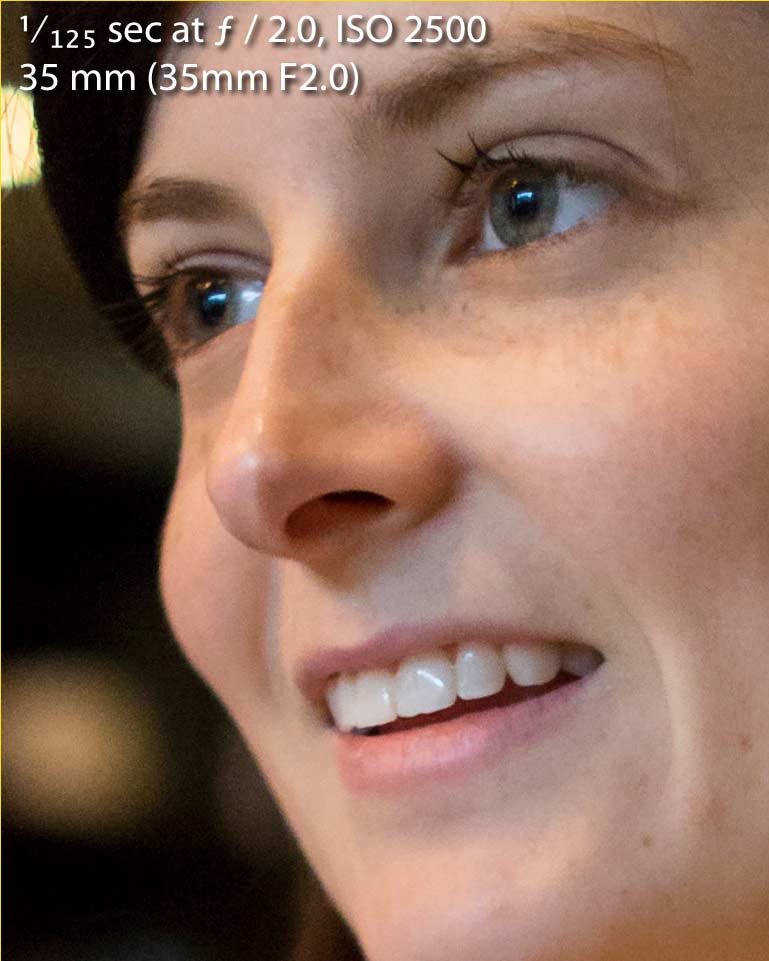
Actual Pixels 100% Crop
What you see above is a 100% crop, with basic Lightroom processing. It’s a bit soft (likely camera shake), but what woman wants a sharp portrait? Noise? What Noise? In a 13X19″ print the image is essentially noiseless. (Yes, there is a little chromatic aberration on the highlight at the top left of frame of the crop. Again, not really visible on a normal sized print. But, I never said the lens was perfect, especially wide open. We’re in pixel-peeper land at this point. A 13X19″ print looks fantastically sharp.

ISO 6400 Full Frame
Above is a shot at ISO 6400 taken at the same time, at the same dimly lit restaurant. Below is a 100% crop.
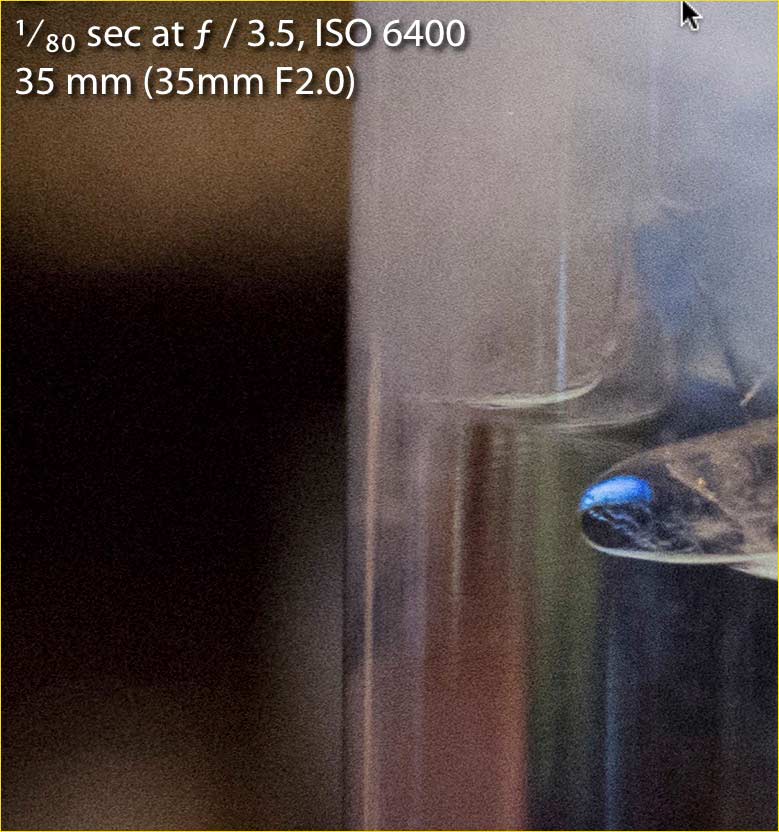
100% Crop
Now, you can see some noise, especially at such huge magnification. At normal print size it’s visible, but can be easily cleaned up with a quick adjustment in Lightroom. The noise at this level still seems to be predominantly luminance, with hardly a hint of chroma noise. As I said, except on a tripod with a stationary subject I’m happy to shoot with Auto ISO set to a maximum of 6400.That’sshooting freedom.
There isn’t much point in doing the usual gratuitous series of ISO frames. If you shoot raw, process in the current version of Lightroom or Camera Raw, and don’t make wall sized prints, ISOs from 50 to 3200 are eminently usable. 6400 needs a touch of luminance clean-up and 12,500 and 25,000 are somewhat noisy but also quite usable with a bit of work. Quite remarkable actually. The Nikon D600 and the Sony A99 are similarly strong players in the clean high-ISO sweepstakes. Frankly, ultra-high ISO shooting seems a bit of a fetish among pixel-peepers, because with an f/2 or faster lens noise-free ISO 3200 is eminently usable under just about any real-world lighting conditions. Using astro ISOs seems more about bragging rights than actual photography.
Flash
The RX1 has a built-in pop-up flash. As all such units in compact cameras this is most suitable for casual use and fill-in. One big disappointment is that unlike the similar flash units in the NEX series cameras the flash head can not be manually titled upward for ceiling bounce. Shame on you Sony for omitting this valuable capability.
The camera has a standard type hot-shoe that accept either new series Sony flash guns (not yet released), or the older design for the Minolta / Sony locking mount, via an optional adaptor. The camera will take generic manual flash units as well.
Video Audio
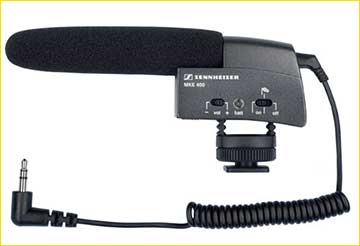
Sennheiser MKE 400 Compact Shotgun Microphone
On the plus side of the ledger Sony has included a mini-phono-jack for an external microphone. On the negative side we find that there are no manual audio level controls available. Once again, shame on Sony for omitting this on such a premium product. The built in stereo mics are “OK” for casual use, but for decent audio without the bother of a stand-alone dual-system recorder, not being able to control audio levels is a serious omission.
If you’re looking for a small decent quality mic for video onanycompact stills or video camera I recommend the Sennheiser MKE 400 Compact Shotgun Microphone as an appropriate choice . I’ve had one for a few years and know of nothing with comparable small size and quality for the price. The MKE 400 retails for about $200.
Compared to?
There really isn’t a comparable camera currently on the market. Certainly not one with a full-frame 24MP sensor and a compact size. Cameras which some people may want to consider that serve a similar purpose, are theLeica X2, with its 16MP APS-C sized sensor, equivalent focal length lens (though at f/2.8 a stop slower), and available electronic viewfinder. Certainly theSigma DP2 Merrill, which I’ve had very high regard for (in terms of image quality) is one to consider, and costs almost half as much as the X2, and nearly a third that of the RX1.
I have no experience with the X2, but I do with the DP2M. I’ve done some image comparisons between the two, and I’ll state categorically that the DP2M has higher resolution. It doesn’t match the RX1 in any other way, butmanthat Foveon sensor and the camera’s built-in lens are stunning. (No, I will not publish comparison results. These cameras use different sensor technology, different raw software, have different sized sensors and have different resolutions. Any comparison between cameras is difficult and will invariably bring the country folk to the castle gate with pitchforks in hand, so I’ll simply say that if you want the better all-around camera, it’s the RX1, but that the DP2M produces sharper and higher resolution results at normal print sizes, as well as on screen).
Source of Confusion
The RX1 is highly configurable. There are three custom positions on the main Mode dial and these are easily settable via the menu system. A possible source of confusion though is that unlike most cameras with auto-exposure systems and lenses with aperture rings, the ring on the RX1 has no “A” position. Usually to use the camera in either fully automatic or shutter priority mode, the aperture ring is set to A. Sony’s RX1? No “A”, eh?
Instead, if you set the camera to Full Auto-Exposure or Shutter Speed Priority exposure modes, the aperture set on the lens ring does nothing. It is irrelevant. In ordinary use this becomes obvious and isn’t an issue. But if you have programmed C1, C2, or C3 on the Mode dial with a particular mode setting, but forget what it is, you may find yourself turning the aperture ring on the lens and wondering why it isn’t having any effect. Not a big deal, but something that tripped me up once or twice when I was first using the camera.

A Star is Born. San Miguel de Allende, Mexico. December, 2012
Sony RX1 @ ISO 250
Sony’s Stubborn Obtuseness
I know that I’m playing a broken record, but let me once again chastise Sony for what is almost certainly the most obtuse in-camera image review process of any camera maker. As we know industry standards require that certain types of files be placed in prescribed subdirectories on the card’s directory structure. But with the exception of Sony every other camera maker automatically figures this out and displays mixed stills and video during in-camera review in the order that they were shot. Not Sony.
On Sony cameras if you are shooting stills and press Review, you see only your raws and JPGS. You have to move though some menus to find the videos, and sometimes this can be downright scary. For example – you have just shot a couple of hundred stills to a card. Now you press the Video button and shoot a few seconds, either intentionally or by accident. In any event you press Review, then press Delete. The screen reads (Deleting files)plural, even if it’s just one file.Oh Oh. Now the screen says, “No files visible in this view“. Did all my raws just get zapped?! (It’s actually better now that it used to be. Last year it just said.No Files).
Please Sony, put your best engineers on this project and have them figure out what the rest of the industry has known how to do forever; that is to mix stills and videos during on-screen review. Is it really that hard to do?
Conclusion
I hate sounding like a fanboy, but I must say that the Sony RX1 presses all the right buttons for me – no pun intended. Build quality is exemplary, haptics are mostly excellent, as are control placement and customizability. The Zeiss lens is truly excellent, and having a full-frame 24MP camera that can fit in a coat pocket and go almost anywhere without being an encumbrance makes this camera greatly appealing. One can always find quibbles in any piece of equipment, but the RX1 is more operationally all-of-a-piece and desirable than just about any recent camera in my experience.
Of course there’s the issue of price, but frankly it’s hard to imagine a camera being as well made with as terrific a lens for much less money. Quality costs.
The only competitor on the horizon that I can see is the forthcoming new Leica M, due late winter or early spring 2013. It too will be full frame, 24 Megapixel and have an accessory EVF. Of course it will be quite a bit larger, heavier, andmuchmore expensive even without a lens, but the comparisons will be inevitable and as a long-time Leica aficionado I’ll be among the first to do them.
In the meantime, unlike most cameras that cross my desk, the Sony RX1 has captured my attention and admiration. Indeed I bought one as soon as I could because it’s just the ticket for the kind of travel and documentary shooting that I so much enjoy doing.
December, 2012
A special thanks to Anthony atVistekin Toronto for assisting me in getting my RX1
just a few days before my annual migration south to Mexico for the winter. Much appreciated.
You May Also Enjoy...
Bringing Xenon Flash to the Adaptalux Studio
FacebookTweet Publisher’s Note: On occasion, The Luminous Landscape sees fit to support and promote unique or useful photographic technologies and campaigns by small start-ups and individuals.
SMA Workshops
Winter 2012 – 2013 ScheduleSORRY – SOLD OUTAccepting Waitlist Requests San Miguel de AllendeDuring winter 2012 – 2013 I will be teaching three Master Class


